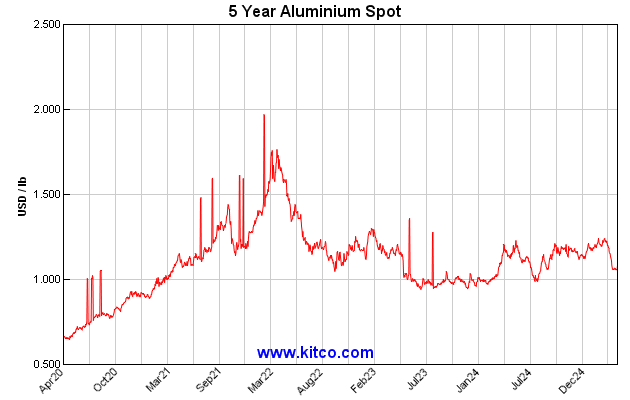|
Aluminium
Aluminium is a relatively new metal, it was discovered in 1827, but could not be produced efficiently until 1895.
Aluminium competes with steel in many of its uses, but aluminium has the advantage of being lighter, corrosion resistent, a good conductor of electricity and strong when alloyed.
Applications
Aluminium is widely used in the construction, transport, and packaging industries. Aluminium's attributes are ideal for the construction business. The metal is strong, light, corrosion resistent and versatile. It is used in construction, for windows, doors, cladding, weather-proofing, light constructions such as conservatories and canopies.
In transport, aluminium is used in the auto, aerospace, rail and marine industries, again its strength, lightness and resistence to corrosion means it is ideally suited for both the construction of the shell / bodies as well as many of the working parts, fixtures, fittings and engine components. In aircraft, aluminium and aluminium alloys account for around 80% of an aircrafts unladen weight. In auto production, aluminium is gaining market share from steel for vehicles bodies, engine blocks, engine components and wheels. Its use for railway carridges and for ships hulls, fixtures and fittings, all mean considerable weight savings compared to their steel counterparts.
Packaging, aluminium is used extensively for the protection, storage and preparation for food and drinks. Again its lightness, especially compared to glass, helps to reduce transportation costs. Aluminium foil is light, strong and flexible and is a barrier to air, light and micro-organisms, which all help food preservation.The aluminium can has all the above advantages, but it is also easily recyclable, which makes it an environmentally friendly packaging material.
Electrical uses. Aluminium is used in overhead and underground power-lines and power cables. Aluminium weighs only one-third as much as copper and one kilogram of aluminium cable can carry twice as much electricity as one kilogram of copper cable.
Water treatment and medicine. Aluminium hydroxide is used as a antiacid to combat gastic upsets, while aluminium chloride and chlorohydrate is used widely in anti-perspirants. Water treatment also uses aluminium sulphate to purify waste water.

Demand
With some many applications it is of little surprise that aluminium has rapidly become the largest base metal in terms of tonnage consumed annually. With all aspects of its use likely to benefit from continuing growth in the developed economies aluminium has a stable outlook, however, with the rapid industrialisation and urbanisation of countries like China and India, aluminium demand is set to accelerate sharply. Primary aluminium demand has risen from 2 million tonnes in 1950, to 9.5 million tonnes in 1970, to 15 million tonnes in 1990 and is expected to rise to 23 million tonnes in 2005.

Supply
Production of primary aluminium is done in three stages. It starts with the mining of bauxite, a reddish-brown aluminous earth found in tropical latitudes in Australia, South America, India, the Caribbean and Africa. Bauxite is then refined to produce alumina, which is then smelted to produce aluminium. To produce one tonne of primary aluminium takes two tonnes of alumina, which in turn takes four tonnes of bauxite.
The reduction of aluminium from its oxide, alumina, is very power-intensive, hence why significant parts of world primary aluminum production are located near cheap energy sources, whether it be hydro-electric power in Canada or near the oil and gas fields in the Middle East. Interestingly, when OPEC limited oil exports in the Middle East in the 1970's, oil producing countries found themselves with surplus oil production capacity which they were not allowed to export. Instead they converted the oil and gas to electricity and produced aluminium which could then be exported. A very clever way to get around the OPEC restrictions.
It is important to understand the huge energy requirement need to make primary aluminium. The Hillside smelter in South Africa produces around 460,000 tpy of aluminium, but to do so takes the of equivalent to about 5% of all the electricity consumed in South Africa.
Recycled aluminium plays an important part of the supply chain as aluminium's use in packaging often has a short life span. To produce aluminium from scrap aluminium costs a fraction of the cost of producing primary aluminium. To produce one tonne of aluminium from scrap consumes only 5% of the amount of electricity that it takes to produce one tonne of primary aluminium.
Factors affecting supply
The production of aluminium requires alumina and uninterrupted supply of electricity. Compared with the production of metals, aluminium's requirements are fairly straight forward. However, in recent years there have been a host of issues which have affected supply. Most of these have been to do with electricity. In the 2001, energy shortages in the US sent electricity prices spirallying higher to the extent that it was more profitable for some aluminium smelters to stop producing aluminium and to sell their electricity quotas to other users. The cutbacks were enough to turn the aluminium price around. Back in the mid-1990's, lack of rainfall in North America restricted hydro-electrical output and in turn this forced aluminium producers to cut back aluminium production. More recently, hurricane damage in the Caribbean in 2004 affected alumina production and as this threathened aluminia supply to the smelters, it led to higher aluminium prices. Likewise, China's growth spurt has left it short of power capacity, so at peak energy usage times, such as during the summer when air conditioning consumers huge amounts of energy, aluminium smelters sometimes have to cut production, to free-up electricity for other users. These are a few of the factors that can impact the aluminium market.
|





 Digg
Digg Del.icio.us
Del.icio.us StumbleUpon
StumbleUpon Netscape
Netscape Yahoo
Yahoo Technorati
Technorati Googlize this
Googlize this Facebook
Facebook